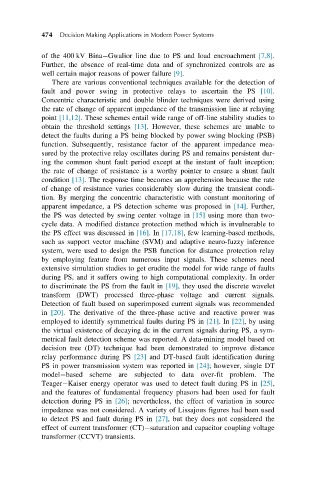Page 514 - Decision Making Applications in Modern Power Systems
P. 514
474 Decision Making Applications in Modern Power Systems
of the 400 kV Bina Gwalior line due to PS and load encroachment [7,8].
Further, the absence of real-time data and of synchronized controls are as
well certain major reasons of power failure [9].
There are various conventional techniques available for the detection of
fault and power swing in protective relays to ascertain the PS [10].
Concentric characteristic and double blinder techniques were derived using
the rate of change of apparent impedance of the transmission line at relaying
point [11,12]. These schemes entail wide range of off-line stability studies to
obtain the threshold settings [13]. However, these schemes are unable to
detect the faults during a PS being blocked by power swing blocking (PSB)
function. Subsequently, resistance factor of the apparent impedance mea-
sured by the protective relay oscillates during PS and remains persistent dur-
ing the common shunt fault period except at the instant of fault inception;
the rate of change of resistance is a worthy pointer to ensure a shunt fault
condition [13]. The response time becomes an apprehension because the rate
of change of resistance varies considerably slow during the transient condi-
tion. By merging the concentric characteristic with constant monitoring of
apparent impedance, a PS detection scheme was proposed in [14]. Further,
the PS was detected by swing center voltage in [15] using more than two-
cycle data. A modified distance protection method which is invulnerable to
the PS effect was discussed in [16].In [17,18], few learning-based methods,
such as support vector machine (SVM) and adaptive neuro-fuzzy inference
system, were used to design the PSB function for distance protection relay
by employing feature from numerous input signals. These schemes need
extensive simulation studies to get erudite the model for wide range of faults
during PS, and it suffers owing to high computational complexity. In order
to discriminate the PS from the fault in [19], they used the discrete wavelet
transform (DWT) processed three-phase voltage and current signals.
Detection of fault based on superimposed current signals was recommended
in [20]. The derivative of the three-phase active and reactive power was
employed to identify symmetrical faults during PS in [21].In [22], by using
the virtual existence of decaying dc in the current signals during PS, a sym-
metrical fault detection scheme was reported. A data-mining model based on
decision tree (DT) technique had been demonstrated to improve distance
relay performance during PS [23] and DT-based fault identification during
PS in power transmission system was reported in [24]; however, single DT
model based scheme are subjected to data over-fit problem. The
Teager Kaiser energy operator was used to detect fault during PS in [25],
and the features of fundamental frequency phasors had been used for fault
detection during PS in [26]; nevertheless, the effect of variation in source
impedance was not considered. A variety of Lissajous figures had been used
to detect PS and fault during PS in [27], but they does not considered the
effect of current transformer (CT) saturation and capacitor coupling voltage
transformer (CCVT) transients.

